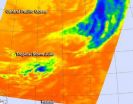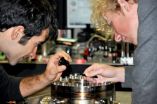(Press-News.org) Tropical Storm Julio doesn't have any strong thunderstorms or strong convection left in it according to infrared satellite imagery from NASA.
When NASA's Aqua satellite passed over Tropical Storm Julio on August 14 at 12:23 UTC (8:23 a.m. EDT), the Atmospheric Infrared Sounder known as AIRS analyzed the clouds and temperatures of the storm. The AIRS data showed that cloud tops had warmed and dropped lower in the atmosphere. That indicates that the strength behind rising air had weakened and was not forming strong, high thunderstorms with cold cloud tops.
There was a small area of cold cloud tops just southeast of the center of circulation where temperatures were near 230 kelvin (-43.1C/ -45.6F). That indicated the strongest storms in the tropical cyclone. Cloud top temperatures throughout the rest of the storm were warmer and weaker.
NOAA's Central Pacific Hurricane Center (CPHC) noted that the system remained devoid of strong convection (rising air that forms thunderstorms that make up a tropical cyclone) on August 15. That's because there was moderate vertical wind shear battering the storm, and Julio was continuing movement over increasingly cooler sea surface temperatures. Sea surface temperatures of at least 80F (26C) are needed to maintain the strength and Julio is moving north into temperatures below that threshold, which will continue to weaken it. CPHC noted that with no deep convection near the center to fuel the system, Julio is expected to continue weakening and lose its tropical characteristics.
Julio is so far from Hawaii and any land areas that there are no coastal watches or warnings in effect.
On August 15 at 0900 UTC (5 a.m. EDT) the center of Tropical Storm Julio was located near latitude 32.4 north and longitude 157.3 west, about 765 miles (1,235 km) north of Honolulu, Hawaii. Maximum sustained winds were near 45 mph (75 kph) but weakening. Julio is moving toward the north-northeast near 5 mph (7 kph). Julio is expected to turn toward the north, then toward the northeast over the next two days.
Julio is forecast to weaken to a tropical depression later on August 15, and a remnant low pressure areas before the day's end.
INFORMATION:
Text credit: Rob Gutro
NASA's Goddard Space Flight Center
NASA sees no punch left in Tropical Storm Julio
2014-08-15
ELSE PRESS RELEASES FROM THIS DATE:
Bigger government makes for more satisfied people, international Baylor study finds
2014-08-15
People living in countries with governments that spend more on social services report being more contented, according to a Baylor University study.
"The effect of state intervention into the economy equals or exceeds marriage or employment status — two traditional predictors of happiness — when it comes to satisfaction," said Patrick Flavin, Ph.D., assistant professor of political science in Baylor's College of Arts & Sciences.
The study — "Assessing the Impact of the Size and Scope of Government on Human Well-Being" — is published in the journal Social Forces. The researchers ...
Dynamic culture of a thermosensitive collagen hydrogel improves tissue-engineered peripheral nerve
2014-08-15
Tissue engineering technologies offer new treatment strategies for the repair of peripheral nerve injury, but cell loss between seeding and adhesion to the scaffold remains inevitable. In a study reported on the Neural Regeneration Research (Vol. 9, No. 14, 2014), a thermosensitive collagen hydrogel remained as a liquid when kept at temperatures below 10°C and gelled when the temperature was increased to 37°C in an incubator for 30 minutes, which was used as an extracellular matrix and combined with bone marrow mesenchymal stem cells to construct tissue-engineered peripheral ...
Incentives, innovation and growth
2014-08-15
Over the past decades, the economic sciences have seen fundamental breakthroughs in our understanding of human responses to incentives in the face of uncertainty and strategic interactions. But what is the scope and what are the limits for applying these models in the design of better institutions and better policies? And to what extent can they teach us what is needed to encourage the innovation that drives economic growth and social wellbeing? These are among the questions to be debated among 17 Nobel Laureates in Economic Sciences and approximately 450 aspiring young ...
New ways to treat solid tumors
2014-08-15
An international team of scientists has shown that an antibody against the protein EphA3, found in the micro-environment of solid cancers, has anti-tumour effects.
As EphA3 is present in normal organs only during embryonic development but is expressed in blood cancers and in solid tumours, this antibody-based approach may be a suitable candidate treatment for solid tumours.
The researchers from Monash University and Ludwig Cancer Research, in Australia, and KaloBios Pharmaceuticals, in the US, have had their findings published in the journal Cancer Research.
The ...
Guidelines can predict early menopause in child cancer survivors
2014-08-15
Girls with cancer who are most likely to become infertile after treatment can be identified using guidelines developed almost 20 years ago, new research shows.
The criteria – developed in Edinburgh – will help to select which girls should be offered the opportunity to freeze some tissue from their ovaries for use in the future.
Doctors are optimistic that the frozen tissue could one day help young cancer survivors to have children of their own.
Some cancer treatments can affect female fertility by bringing on early menopause. Freezing samples of ovary tissue before ...
Bats bolster brain hypothesis, maybe technology, too
2014-08-15
PROVIDENCE, R.I. [Brown University] — Amid a neuroscience debate about how people and animals focus on distinct objects within cluttered scenes, some of the newest and best evidence comes from the way bats "see" with their ears, according to a new paper in the Journal of Experimental Biology. In fact, the perception process in question could improve sonar and radar technology.
Bats demonstrate remarkable skill in tracking targets such as bugs through the trees in the dark of night. Brown University neuroscience Professor James Simmons, the review paper's author, has long ...
A study of possible extended symmetries of field theoretic systems
2014-08-15
There has been much recent interest, especially among cosmologists, in theories known as galileons. Galileons are an interesting and novel, though still hypothetical, class of effective scalar fields which are extremely universal and have attracted much recent attention. They arise generically in describing the short distance behavior of the new degrees of freedom introduced during the process of modifying gravity, and in describing the dynamics of extra dimensional brane worlds. Modified gravity and brane worlds are just some of the ideas that have been studied as possible ...
Low vitamin D levels linked to increased risks after noncardiac surgery
2014-08-15
August 15, 2014 – Patients with low blood levels of vitamin D are at increased risk of death and serious complications after noncardiac surgery, suggests a study in Anesthesia & Analgesia.
"Vitamin D concentrations were associated with a composite of in-hospital death, serious infections, and serious cardiovascular events," according to the new research by Dr Alparslan Turan and colleagues of the Cleveland Clinic. They believe their results warrant further study to see if giving vitamin D supplementation before surgery can reduce the risk of these adverse outcomes.
Lower ...
Study: Brain imaging shows brain differences in risk-taking teens
2014-08-15
According to the CDC, unintentional injuries are the leading cause of death for adolescents. Compared to the two leading causes of death for all Americans, heart disease and cancer, a pattern of questionable decision-making in dire situations comes to light in teen mortality. New research from the Center for BrainHealth at The University of Texas at Dallas investigating brain differences associated with risk-taking teens found that connections between certain brain regions are amplified in teens more prone to risk.
"Our brains have an emotional-regulation network that ...
Laser makes microscopes way cooler
2014-08-15
Laser physicists have found a way to make atomic-force microscope probes 20 times more sensitive and capable of detecting forces as small as the weight of an individual virus.
The technique, developed by researchers at The Australian National University (ANU), hinges on using laser beams to cool a nanowire probe to minus 265 degrees Celsius.
"The level of sensitivity achieved after cooling is accurate enough for us to sense the weight of a large virus that is 100 billion times lighter than a mosquito," said Dr Ben Buchler from the ANU Research School of Physics and Engineering.
The ...



